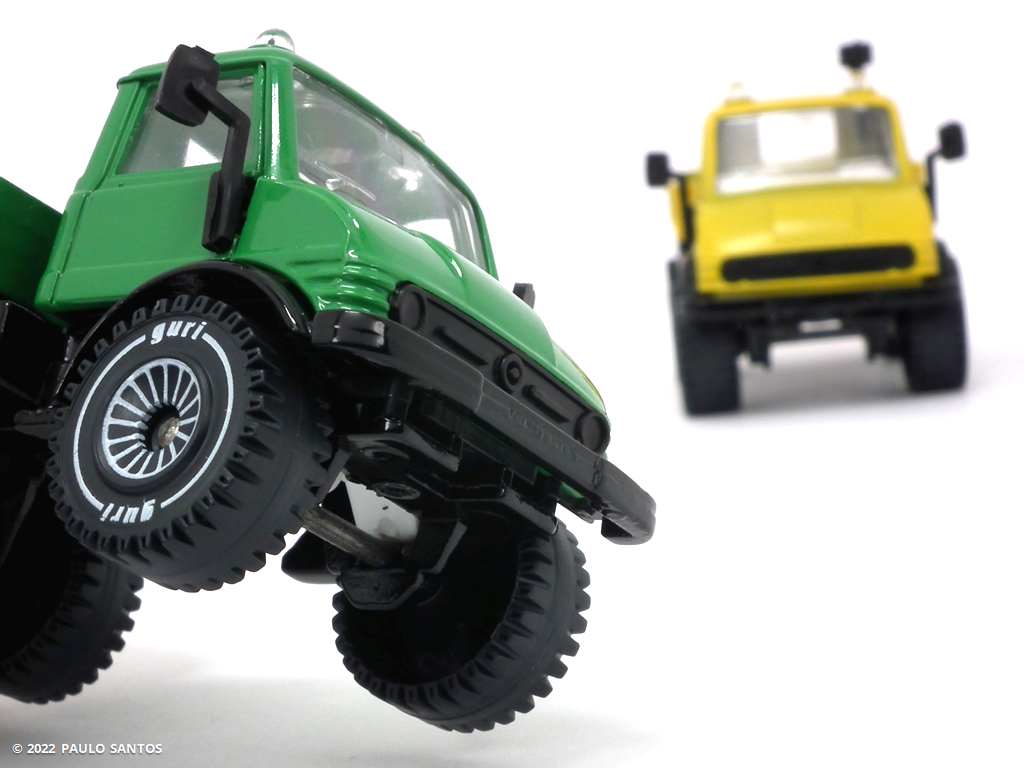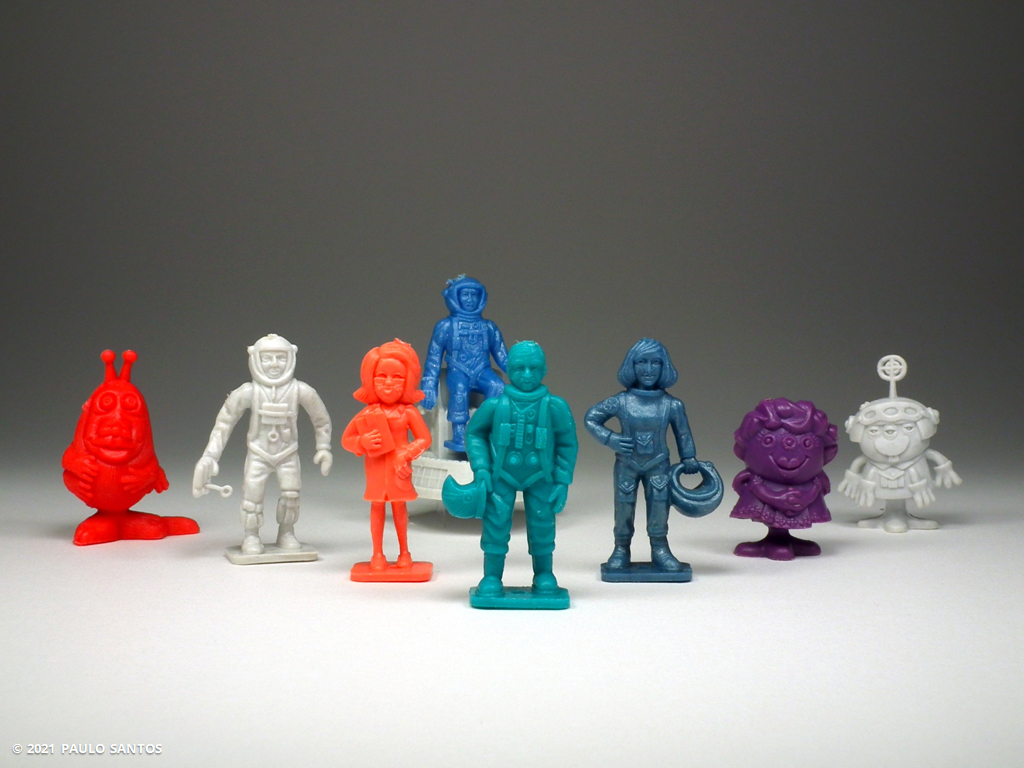Poliguri – Wheel Types
Because I don't know Poliguri's official designation for its wheel types, I have been using a personal classification since 2012, which I share here in the event that it can be useful to other collectors ¹. In this classification, I use the initials of words or expressions in Portuguese to describe the rim pattern, such as "R", for "Raios" (spokes) and, if necessary, the type of tires, such as "T", for "Todo-o-terreno" (all-terrain/off-road), or the size of the wheel, such as "P" or "G", for "Pequena" or "Grande" (small or large). I use numerals to indicate the repetition of the reference element, such as "R5", "com 5 Raios" (with 5 spokes), or of a characteristic, such as "E5", "Estrela com 5 pontas" (star with 5 points).
So far, I have identified eight wheel types used by Poliguri. On the Mercedes 200 and on the Fiat Uno we find the R3, R5, R8 and P8 wheels, with approximately 10 mm in diameter by 6 mm in width. In the first three types, the "rim" protrudes about 1 mm from the tire and has 3, 5 or 8 spokes, highlighted with "chrome" paint. In type P8, the "rim" is highlighted with "chrome" paint and decorated in a concentric way with 8 small circular recesses (and another 4, smaller), visually resembling dots.
On the Mercedes 207 and 307 and on the Peugeot 405 Prototype, as well as on the trailers, we find the R16 wheel, approximately 11 mm in diameter by 6 mm in width. The "rim" is concave, with 16 spokes printed in white. This type has a white stripe printed on the sidewall of the tire, interspersed twice at opposite points with the word "Guri". The Mercedes Unimog comes with R16T wheels. These are larger wheels, approximately 18 mm high by 8 mm wide and with clear off-road capability. Tires come detailed with shoulder blocks. The decoration is identical to the R16.
Playwell models simultaneously feature two types of wheel – E5P at the front, with approximately 12 mm in diameter, and E5G at the rear, with approximately 13 mm. Both types are 4 mm wide. The "rim" protrudes slightly from the tire and shows an embossed 5-pointed star. Both types have a white stripe printed on the sidewall of the tire, which is detailed with the shoulder blocks. The larger diameter rear wheels presumably derive from the need, in versions with a spring mechanism, to give the model greater speed. Ironically, in these simpler versions the rolling characteristics are awful.
Poliguri wheels are molded in black plastic, sometimes with a perceptible grayish shade. The quality of printed details varies, with misalignment of the printed "rims" as well as blurring of inscriptions being reasonably common. The axles used are ±0.9 mm on the R3, R5, R8, P8 and R16 wheels and ±1.8 mm on the R16T wheel. Sometimes, especially in the different versions of the Mercedes 307, the crimping of the axles is rough and holds the wheel, not letting it seat properly. For all intents and purposes, except perhaps for the Fiat Uno, none of the Poliguri models is a good roller. ●
Porque desconheço a designação oficial da Poliguri para os seus tipos de roda, utilizo desde 2012 uma classificação pessoal, que aqui partilho na eventualidade de poder ser útil a outros coleccionadores ¹. Nesta classificação, utilizo as iniciais de palavras ou expressões em Português para descrever o padrão das jantes, como "R", de "Raios" e, se necessário, o tipo de pneus, como "T", de "Todo-o-terreno", ou o tamanho da roda, como "P" ou "G", de "Pequena" ou "Grande". Utilizo algarismos para indicar a repetição do elemento de referência, como "R5", "com 5 Raios", ou de uma característica, como "E5", "Estrela com 5 pontas".
Até agora, identifiquei oito tipos de roda utilizados pela Poliguri. No Mercedes 200 e no Fiat Uno, encontramos as rodas R3, R5, R8 e P8, com aproximadamente 10 mm de diâmetro por 6 mm de largura. Nos três primeiros tipos, a "jante" sobressai cerca de 1 mm do pneu e possui 3, 5 ou 8 raios, destacados com tinta "cromada". No tipo P8, a "jante" é destacada com tinta "cromada" e decorada de forma concêntrica com 8 pequenas reentrâncias circulares (e outras 4, mais pequenas), assemelhando-se visualmente a pontos.
Nos Mercedes 207 e 307 e no Peugeot 405 Prototype, assim como nos atrelados, encontramos a roda R16, com aproximadamente 11 mm de diâmetro por 6 mm de largura. A "jante" é côncava, com 16 raios impressos em branco. Este tipo possui uma risca branca impressa no flanco do pneu, intercalada duas vezes em pontos opostos pela palavra "Guri". O Mercedes Unimog vem com rodas R16T. São rodas maiores, com aproximadamente 18 mm de altura por 8 mm de largura e nítida aptidão todo-o-terreno. Os pneus vêm detalhados com os blocos de ombro. A decoração é idêntica à das R16.
Os modelos Playwell apresentam simultaneamente dois tipos de roda – E5P à frente, com aproximadamente 12 mm de diâmetro, e E5G atrás, com aproximadamente 13 mm. Ambos os tipos possuem 4 mm de largura. A "jante" sobressai ligeiramente do pneu e mostra uma estrela de 5 pontas em relevo. Ambos os tipos possuem uma risca branca impressa no flanco do pneu, que vem detalhado com os blocos de ombro. As rodas traseiras de maior diâmetro derivam presumivelmente da necessidade de, nas versões com mecanismo de mola, se imprimir maior velocidade ao modelo. Ironicamente, nestas versões mais simples as características de rolamento são péssimas.
As rodas da Poliguri são moldadas em plástico preto, por vezes com uma perceptível tonalidade acinzentada. A qualidade dos detalhes impressos varia, sendo razoavelmente comum o desalinhamento das "jantes" impressas, assim como o esborratamento das inscrições. Os eixos utilizados são de ±0,9 mm nas rodas R3, R5, R8, P8 e R16 e de ±1,8 mm na roda R16T. Por vezes, sobretudo nas diversas versões do Mercedes 307, o cravamento dos eixos é grosseiro e prende a roda, não a deixando assentar devidamente. Para todos os efeitos, com excepção talvez para o Fiat Uno, nenhum dos modelos da Poliguri é um bom rolador. ●
¹ In fact, I use this classification for all Portuguese model or toy manufacturers, when I don't know the official designations. | De facto, utilizo esta classificação para todos os fabricantes portugueses de modelos ou brinquedos, quando desconheço as designações oficiais.
R3 (Raios, 3)
3-spoke wheel
Black plastic / chrome rim
Diameter ø ±11 mm
Width ±6 mm
Axle ø ±0,9 mm
R5 (Raios, 5)
5-spoke wheel
Black plastic / chrome rim
Diameter ø ±11 mm
Width ±6 mm
Axle ø ±0,9 mm
R8 (Raios, 8)
8-spoke wheel
Black plastic / chrome rim
Diameter ø ±11 mm
Width ±6 mm
Axle ø ±0,9 mm
P8 (Pontos, 8)
8-dot wheel
Black plastic / chrome rim
Diameter ø ±11 mm
Width ±6 mm
Axle ø ±0,9 mm
R16 (Raios, 16)
16-spoke wheel
Black plastic, white line and lettering / white rim
Diameter ø ±11 mm
Width ±6 mm
Axle ø ±0,9 mm
R16T (Raios, 16, Todo-o-terreno)
6-spoke off-road wheel
Black plastic, white line and lettering / white rim
Diameter ø ±18 mm
Width ±8 mm
Axle ø ±1,8 mm
E5P (Estrela, 5 pontas, Pequena)
5-pointed star wheel, small
Black plastic, white line
Diameter ø ±12 mm
Width ±4 mm
Axle ø ±1,2 mm
E5G (Estrela, 5 pontas, Grande)
5-pointed star wheel, large
Black plastic, white line
Diameter ø ±13 mm
Width ±4 mm
Axle ø ±1,2 mm
Matching the wheels
|
Model |
Wheel |
Ø mm |
Tire/Rim |
|
|
R3, R5, R8, P8 |
±11 |
Black/chrome |
|
|
R3, R5, R8, P8 |
±11 |
Black/chrome |
|
Peugeot 405, Mercedes 207, Mercedes 307 and Trailer
|
R16 |
±11 |
Black, white line/white |
|
|
R16T |
±18 |
Black, white line/white |
|
Playwell
models
|
E5P/E5G |
±12/13 |
Black, white line |
Below, Poliguri's R16 wheels visually resemble Siku's contemporary B04 wheels. There are, however, noticeable differences. ● Em baixo, as rodas R16 da Poliguri assemelham-se visualmente às contemporâneas B04 da Siku. Existem, todavia, perceptíveis diferenças.
References
FM – TOYS & MODELS | "Poliguri – Brief Introduction"
FM – TOYS & MODELS | "Poliguri – Breve Introdução"
FM – TOYS & MODELS | "Poliguri – Spot the Difference"
FM – TOYS & MODELS | "Poliguri – The Playwell Connection"
FM – TOYS & MODELS | "Poliguri – Wheel Types"
FM – TOYS & MODELS | "RESEARCH – Poliguri References"














Comments
Post a Comment